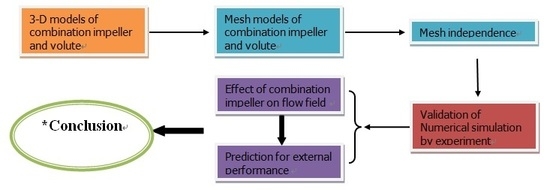Effects of a Combination Impeller on the Flow Field and External Performance of an Aero-Fuel Centrifugal Pump
Abstract
1. Introduction
2. Research Model Description
2.1. Objective
2.2. Configuration and Layout of the Research Model
2.3. 3-D Model
3. Validation Study
3.1. Mesh Model
3.2. Numerical Method and Simulation Conditions
- The pressure is set as the inlet condition, of which the total pressure is prescribed. A given mass flow is imposed at the outlet boundary.
- The fluid is aero-fuel with a density of 779 kg/m3. The temperature for all the regions is set as 20℃ and the kinematic viscosity is 1.48 m2/s.
- The rotating domain of the impeller is a stationary domain with a rotating reference frame. The interface between the impeller and the volute is connected by the technique of the frozen rotor method. Moreover, the blade surfaces, hub, and shroud are set as solid walls. They satisfy the non-slip condition.
- The SIMPLE algorithm is used to solve the pressure-velocity coupling equation. The convergence precisions of all residuals are below the criterion of 1 × 10−5.
3.3. Experiment Setup
3.4. Turbulence Model Verification
4. Simulation Results and Discussions
4.1. Detailed Flow Characteristics of the Studied Pump
4.2. Effects of the Combination Impeller on the Flow Field inside the Impeller and the Volute
4.3. Effects of the Combination Impeller on the External Performance
5. Conclusions
Author Contributions
Funding
Acknowledgments
Conflicts of Interest
References
- Liu, S.Q. Investigation of centrifugal pump used as aero-engine main fuel pump. Aeroengine 2006, 32, 43–45. [Google Scholar]
- Sutton, G.P. History of Liquid Propellant Rocket Engines in the United States. J. Propuls. Power 2003, 19, 978–1007. [Google Scholar] [CrossRef]
- Koyama, N. Utilization of Centrifugal Pumps Used as Hydraulic Turbines. J. Soc. Mech. Eng. 1971, 74, 1584–1587. [Google Scholar]
- Arriaga, M. Pump as turbine–a pico-hydro alternative in Lao People’s Democratic Republic. Renew. Energy 2010, 35, 1109–1115. [Google Scholar] [CrossRef]
- Petrone, G.; De Nicola, C.; Quagliarella, D.; Witteveen, J.; Iaccarino, G. Wind Turbine Performance Analysis Under Uncertainty. In Proceedings of the 49th AIAA Aerospace Sciences Meeting including the New Horizons Forum and Aerospace Exposition, Orlando, FL, USA, 4–7 January 2011; pp. 544–556. [Google Scholar]
- Zhang, J.; Kong, L.; Qu, J.; Wang, S.; Qu, Z. Numerical and experimental investigation on configuration optimization of the large-size ionic wind pump. Energy 2019, 171, 624–630. [Google Scholar] [CrossRef]
- Stepanoff, A.J. Centrifugal and Axial Flow Pumps, Design and Applications; John Wiley and Sons: New York, NY, USA, 1957. [Google Scholar]
- Shen, Z.; Chu, W.; Li, X.; Dong, W. Sediment erosion in the impeller of a double-suction centrifugal pump—A case study of the Jingtai Yellow River Irrigation Project, China. Wear 2019, 422, 269–279. [Google Scholar] [CrossRef]
- Fan, S.Q. Aeroengine Control; Northwestern Polytechnical University Press: Xi’an, China, 2008. [Google Scholar]
- Jiang, Q.; Heng, Y.; Liu, X.; Zhang, W.; Bois, G.; Si, Q. A Review of Design Considerations of Centrifugal Pump Capability for Handling Inlet Gas-Liquid Two-Phase Flows. Energies 2019, 12, 1078. [Google Scholar] [CrossRef]
- Han, W.; Nan, L.; Su, M.; Chen, Y.; Li, R.; Zhang, X. Research on the Prediction Method of Centrifugal Pump Performance Based on a Double Hidden Layer BP Neural Network. Energies 2019, 12, 2709. [Google Scholar] [CrossRef]
- Yan, P.; Chu, N.; Wu, D.; Cao, L. Computational fluid dynamics-based pump redesign to improve efficiency and decrease unsteady radial forces. J. Fluids Eng. 2017, 139, 011101. [Google Scholar] [CrossRef]
- Cao, L.; Zhang, Y.; Wang, Z.; Xiao, Y. Effect of axial clearance on the efficiency of a shrouded centrifugal pump. J. Fluids Eng. 2015, 137, 071101. [Google Scholar]
- Dönmez, A.H.; Yumurtacı, Z.; Kavurmacıoğlu, L. The effect of inlet blade angle variation on cavitation performance of a centrifugal pump: A parametric study. J. Fluids Eng. 2019, 141, 021101. [Google Scholar]
- Zhou, L.; Shi, W.; Li, W.; Agarwal, R. Numerical and Experimental Study of Axial Force and Hydraulic Performance in a Deep-Well Centrifugal Pump With Different Impeller Rear Shroud Radius. J. Fluids Eng. 2013, 135, 104501. [Google Scholar] [CrossRef]
- Jafarzadeh, B.; Hajari, A.; Alishahi, M.M.; Akbari, M. The flow simulation of a low-specific-speed high-speed centrifugal pump. Appl. Math. Model. 2011, 35, 242–249. [Google Scholar] [CrossRef]
- Shojaeefard, M.H.; Tahani, M.; Ehghaghi, M.B.; Fallahian, M.A. Numerical study of the effects of some geometric characteristics of a centrifugal pump impeller that pumps a viscus fluid. Comput. Fluids 2012, 60, 61–70. [Google Scholar] [CrossRef]
- Guo, X.; Zhu, L.; Zhu, Z.; Cui, B.; Li, Y. Numerical and experimental investigations on the cavitation characteristics of a high-speed centrifugal pump with a splitter-blade inducer. J. Mech. Sci. Technol. 2015, 29, 259–267. [Google Scholar] [CrossRef]
- Luo, X.; Zhang, Y.; Peng, J.; Xu, H. Impeller inlet geometry effect on performance improvement for centrifugal pumps. J. Mech. Sci. Technol. 2018, 22, 1971–1976. [Google Scholar] [CrossRef]
- Lundgreen, R.K.; Oliphant, K.; Maynes, D.; Gorrell, S.E. High Suction Performance Pumps with Large Inlet Blade Angles and an Integrated Stability Control Device. In Proceedings of the 52nd AIAA/SAE/ASEE Joint Propulsion Conference, Salt Lake City, UT, USA, 25–27 July 2016; Volume 2016, pp. 4985–4999. [Google Scholar]
- Chen, H.-X.; He, J.-W.; Liu, C. Design and experiment of the centrifugal pump impellers with twisted inlet vice blades. J. Hydrodyn. 2017, 29, 1085–1088. [Google Scholar] [CrossRef]
- Ayad, A.F.; Abdalla, H.M.; Aly, A.A.E.-A. Effect of semi-open impeller side clearance on the centrifugal pump performance using CFD. Aerosp. Sci. Technol. 2015, 47, 247–255. [Google Scholar] [CrossRef]
- Yousefi, H.; Noorollahi, Y.; Tahani, M.; Fahimi, R.; Saremian, S. Numerical simulation for obtaining optimal impeller’s blade parameters of a centrifugal pump for high-viscosity fluid pumping. Sustain. Energy Technol. Assess. 2019, 34, 16–26. [Google Scholar] [CrossRef]
- Hong, S.S.; Kim, D.J.; Kim, J.S.; Choi, C.H. Study on inducer and impeller of a centrifugal pump for a rocket engine turbopump. J. Mech. Eng. Sci. 2013, 227, 311–319. [Google Scholar] [CrossRef]
- Guo, X.-M.; Zhu, Z.-C.; Shi, G.-P.; Huang, Y. Effects of rotational speeds on the performance of a centrifugal pump with a variable-pitch inducer. J. Hydrodyn. 2017, 29, 854–862. [Google Scholar] [CrossRef]
- Li, W.-G. Effects of viscosity on turbine mode performance and flow of a low specific speed centrifugal pump. Appl. Math. Model. 2016, 40, 904–926. [Google Scholar] [CrossRef]
- Stechmann, D.; Sese, C.; Duvvur, R.; Huang, Y.; Bilyeu, M.; Goldberg, D.; King, M.; Zhang, A.; Pourpoint, T.L. Design and Analysis of a High-Pressure Turbopump at Purdue University. In Proceedings of the 51st AIAA/SAE/ASEE Joint Propulsion Conference, Orlando, FL, USA, 27–29 July 2015; Volume 2015, pp. 4216–4240. [Google Scholar]
- Wang, C.; Shi, W.; Wang, X.; Jiang, X.; Yang, Y.; Li, W.; Zhou, L. Optimal design of multistage centrifugal pump based on the combined energy loss model and computational fluid dynamics. Appl. Energy 2017, 187, 10–26. [Google Scholar] [CrossRef]
- Song, Y.; Fan, H.; Zhang, W.; Xie, Z. Flow Characteristics in Volute of a Double-Suction Centrifugal Pump with Different Impeller Arrangements. Energies 2019, 12, 669. [Google Scholar] [CrossRef]
- Tan, L.; Zhu, B.S.; Cao, S.L.; Bing, H. Influence of blade wrap angle on centrifugal pump performance by numerical and experimental study. Chin. J. Mech. Eng. 2015, 27, 171–177. [Google Scholar] [CrossRef]
- Ding, H.; Li, Z.; Gong, X.; Li, M. The influence of blade outlet angle on the performance of centrifugal pump with high specific speed. Vacuum 2019, 159, 239–246. [Google Scholar] [CrossRef]
- Han, X.; Kang, Y.; Li, D.; Zhao, W. Impeller Optimized Design of the Centrifugal Pump: A Numerical and Experimental Investigation. Energies 2018, 11, 1444. [Google Scholar] [CrossRef]
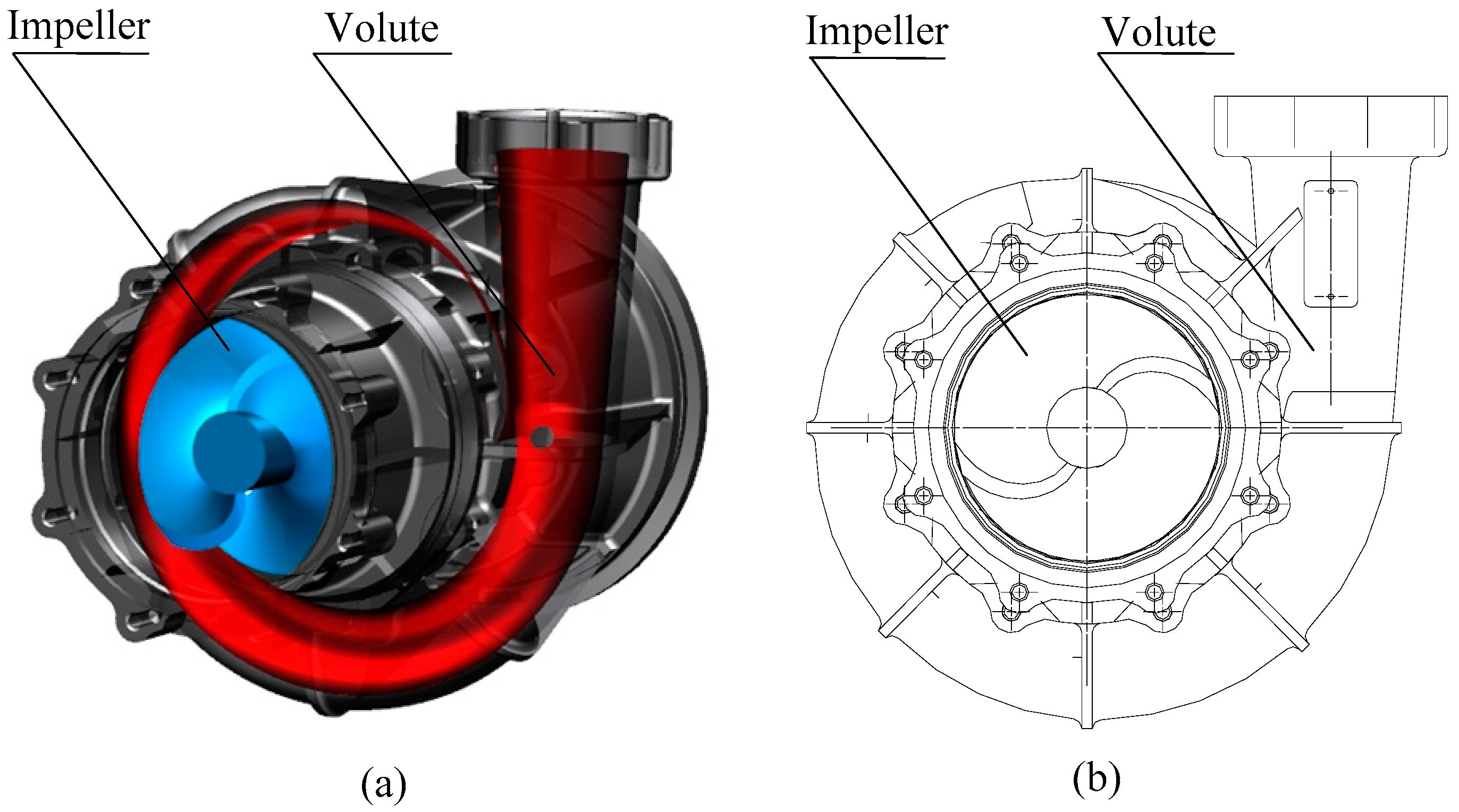
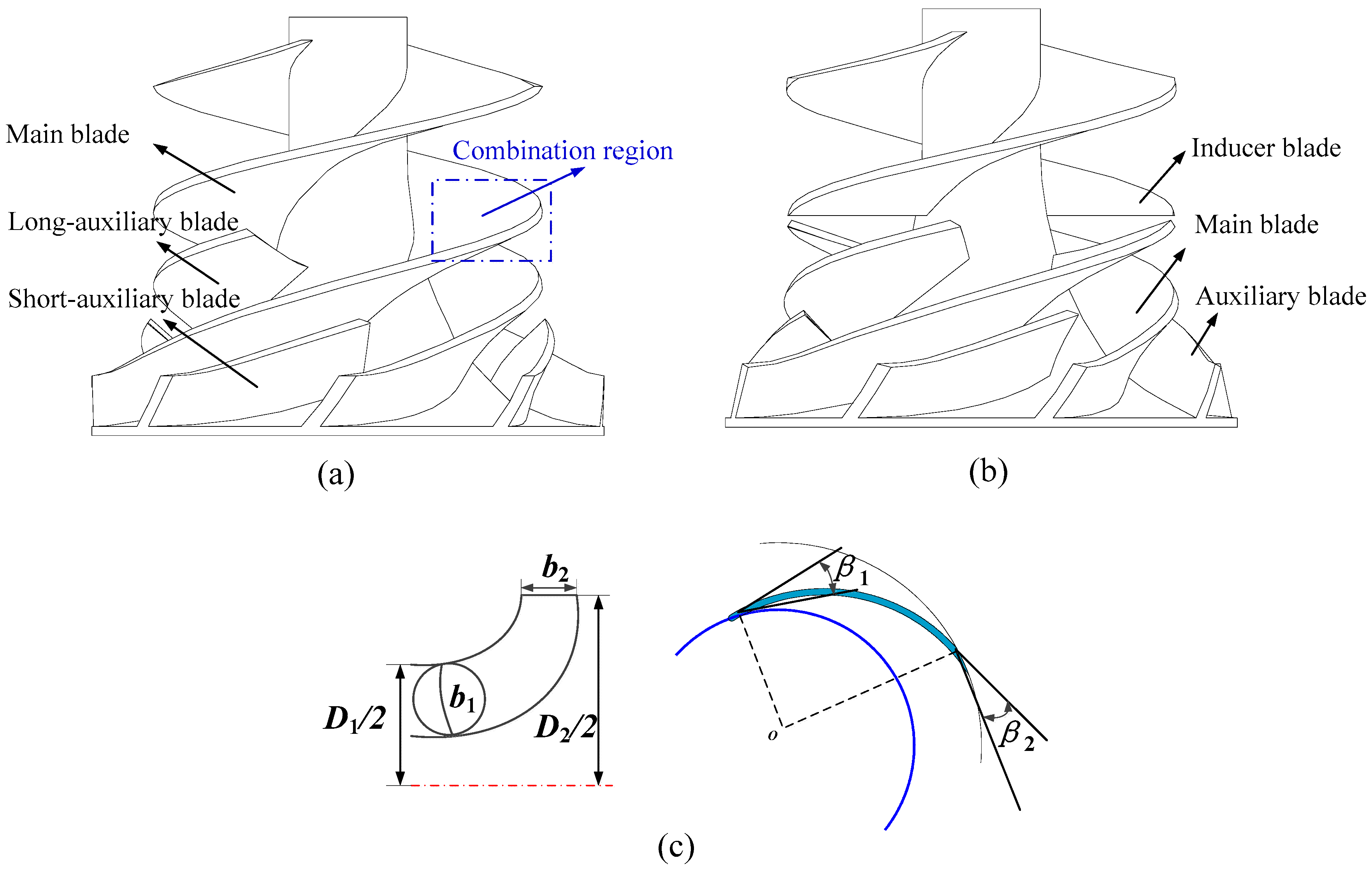

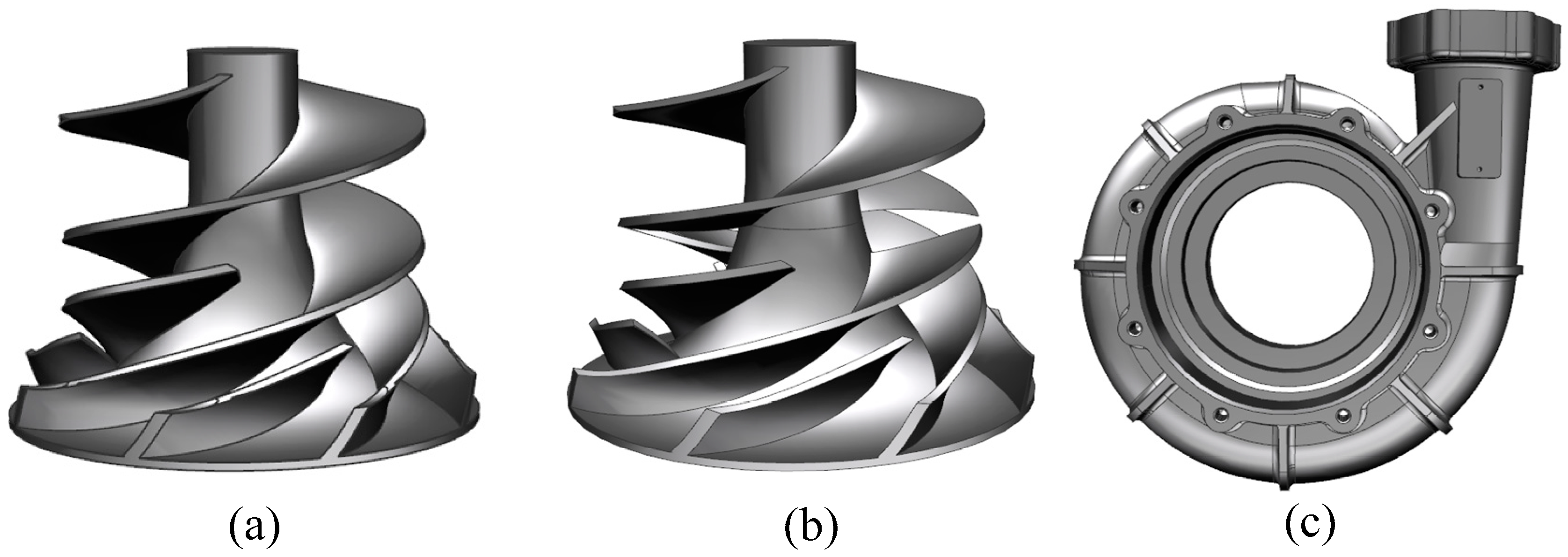
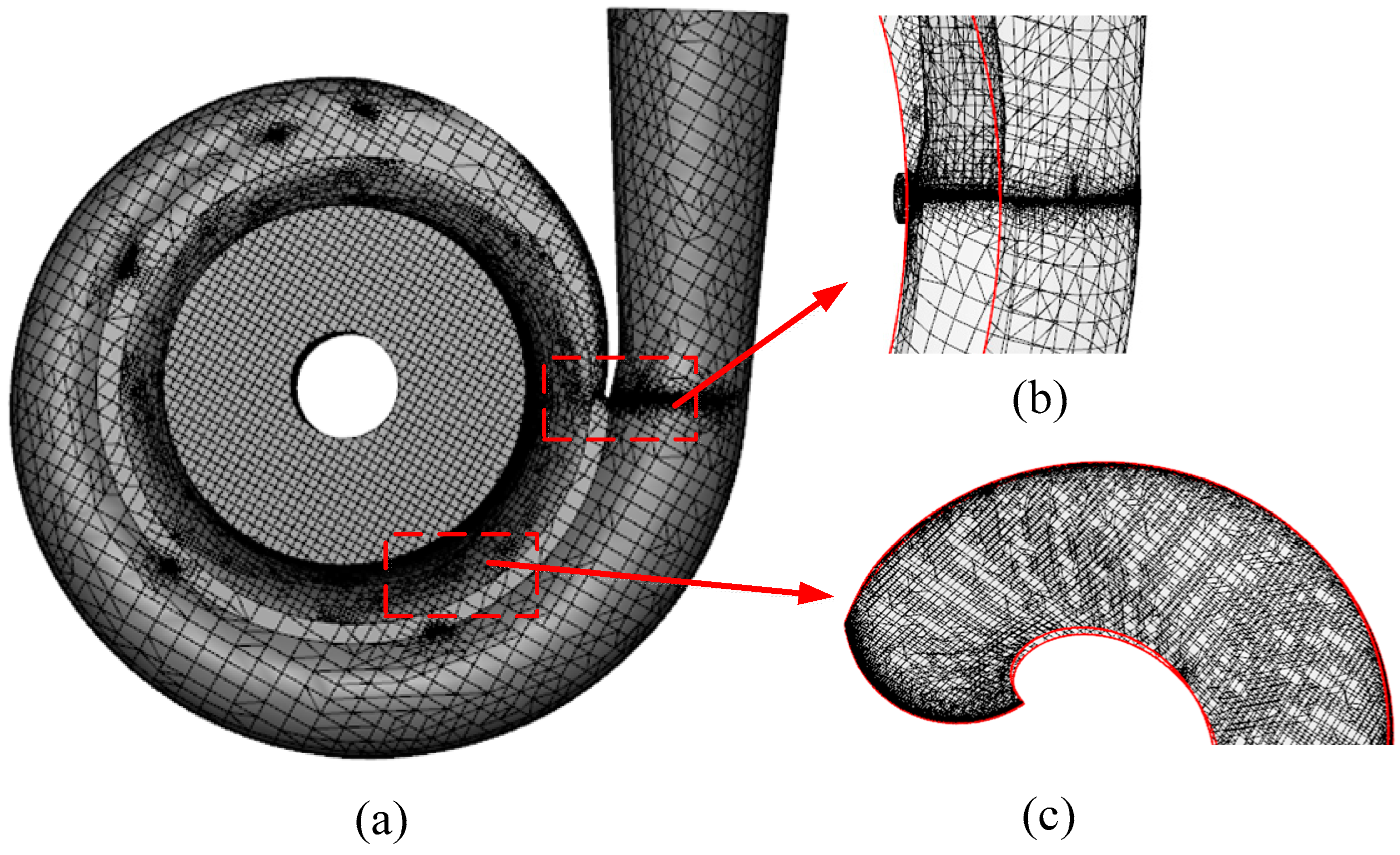

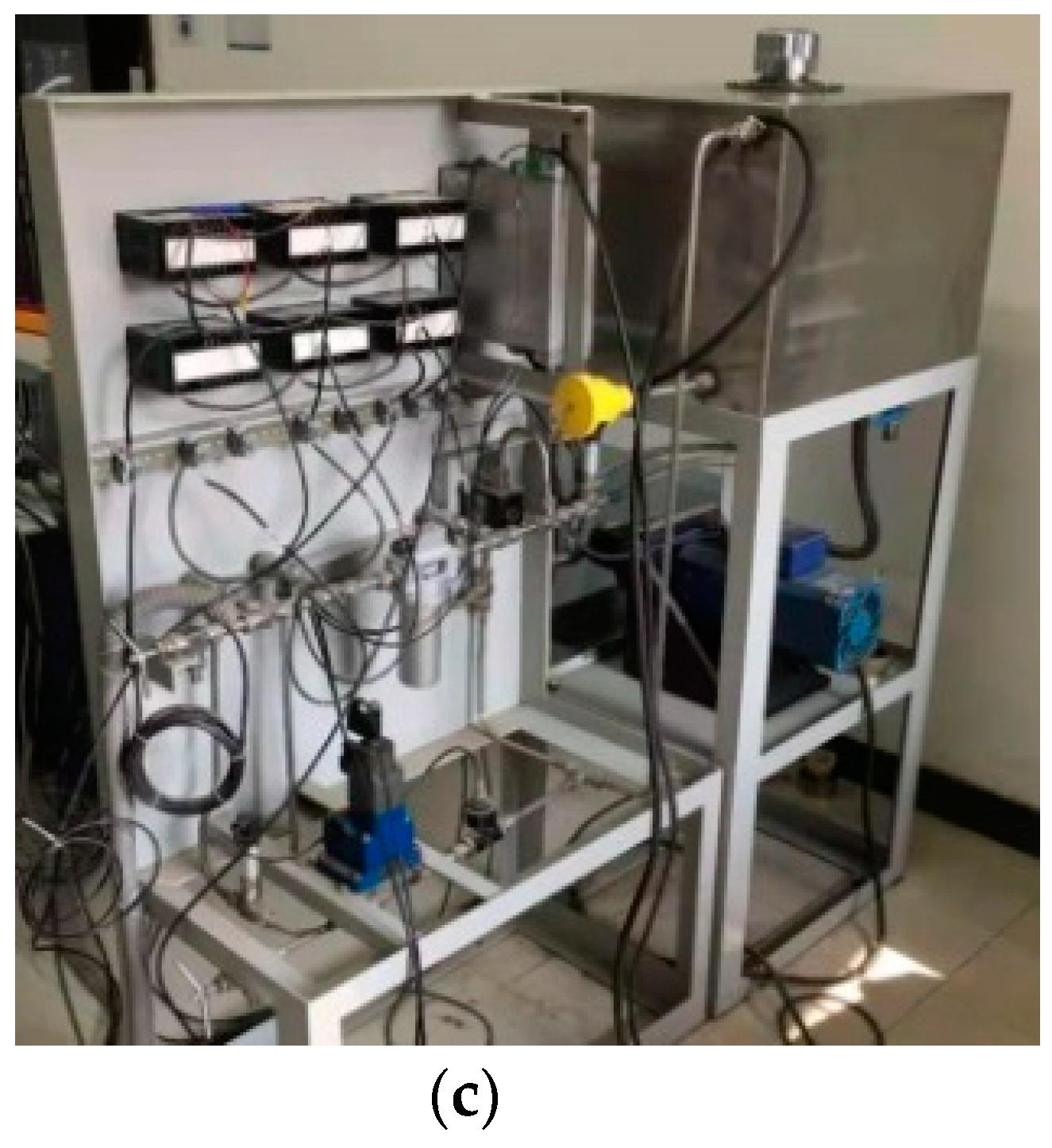
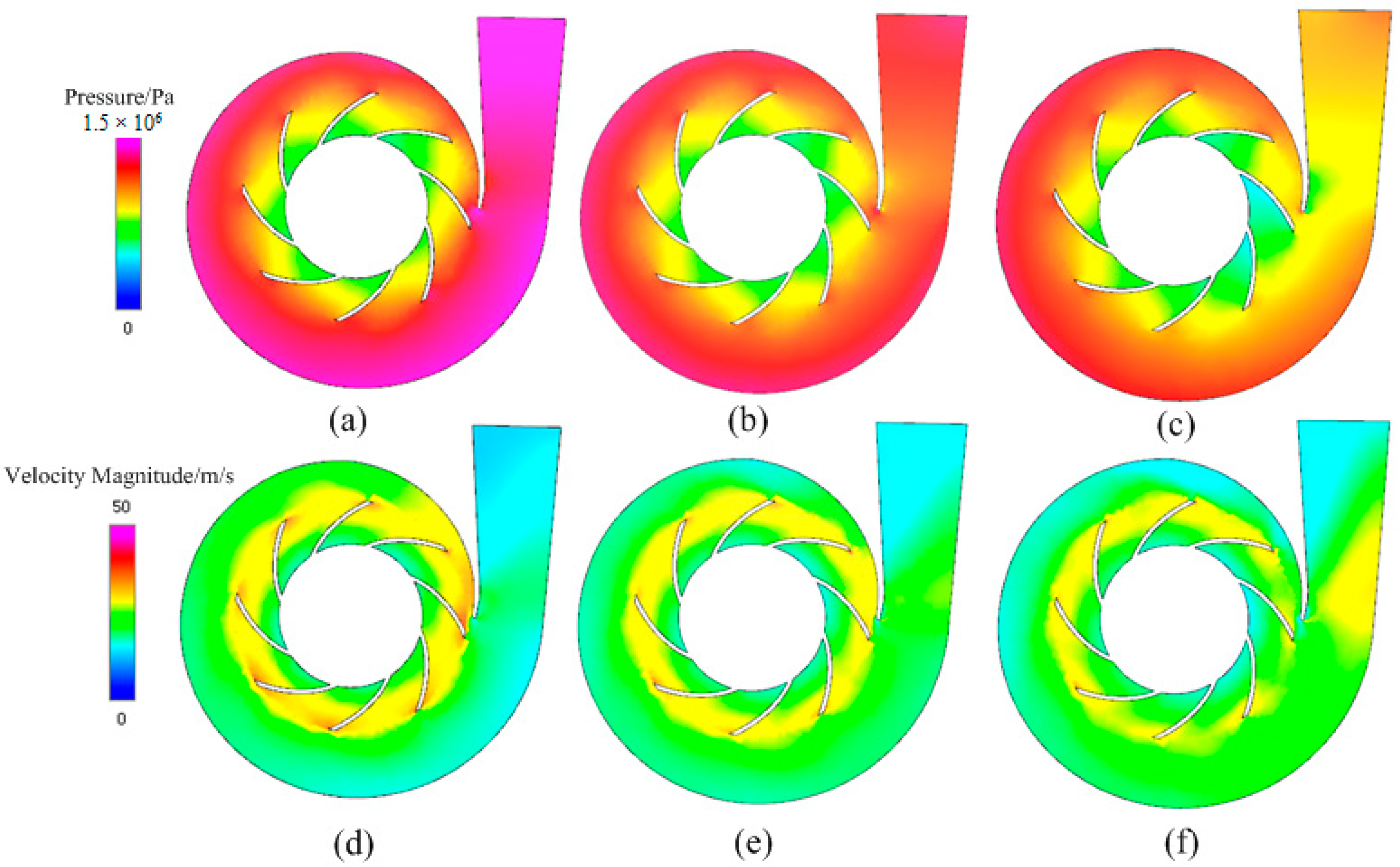
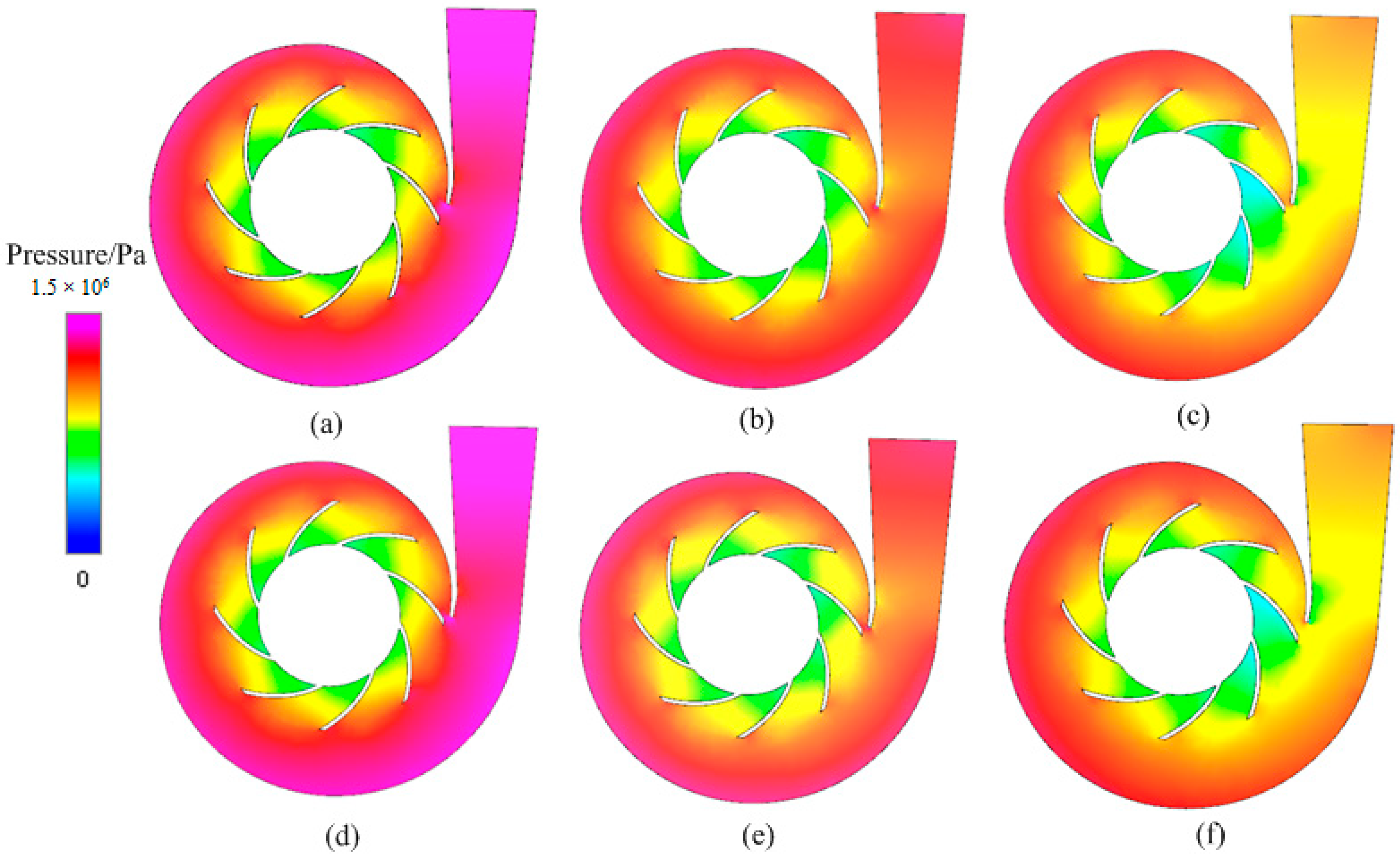
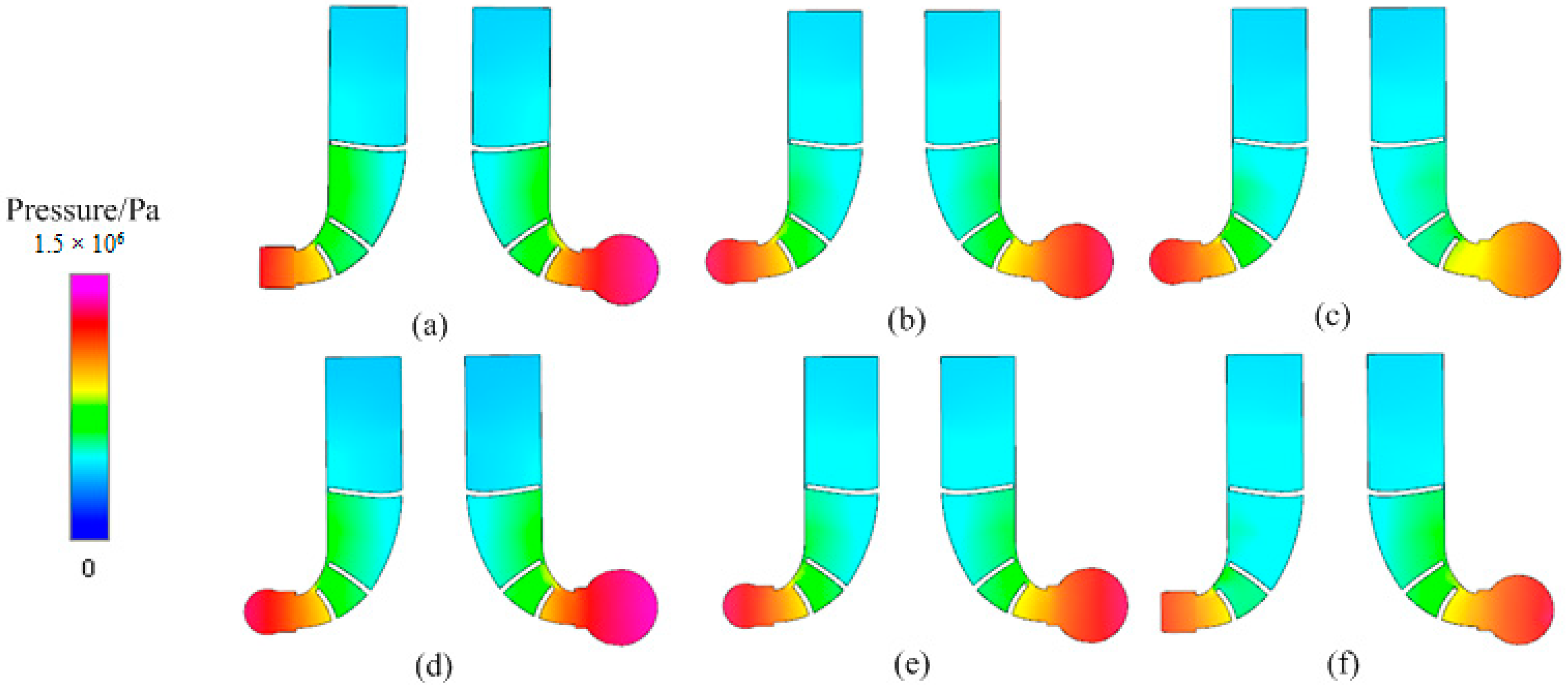
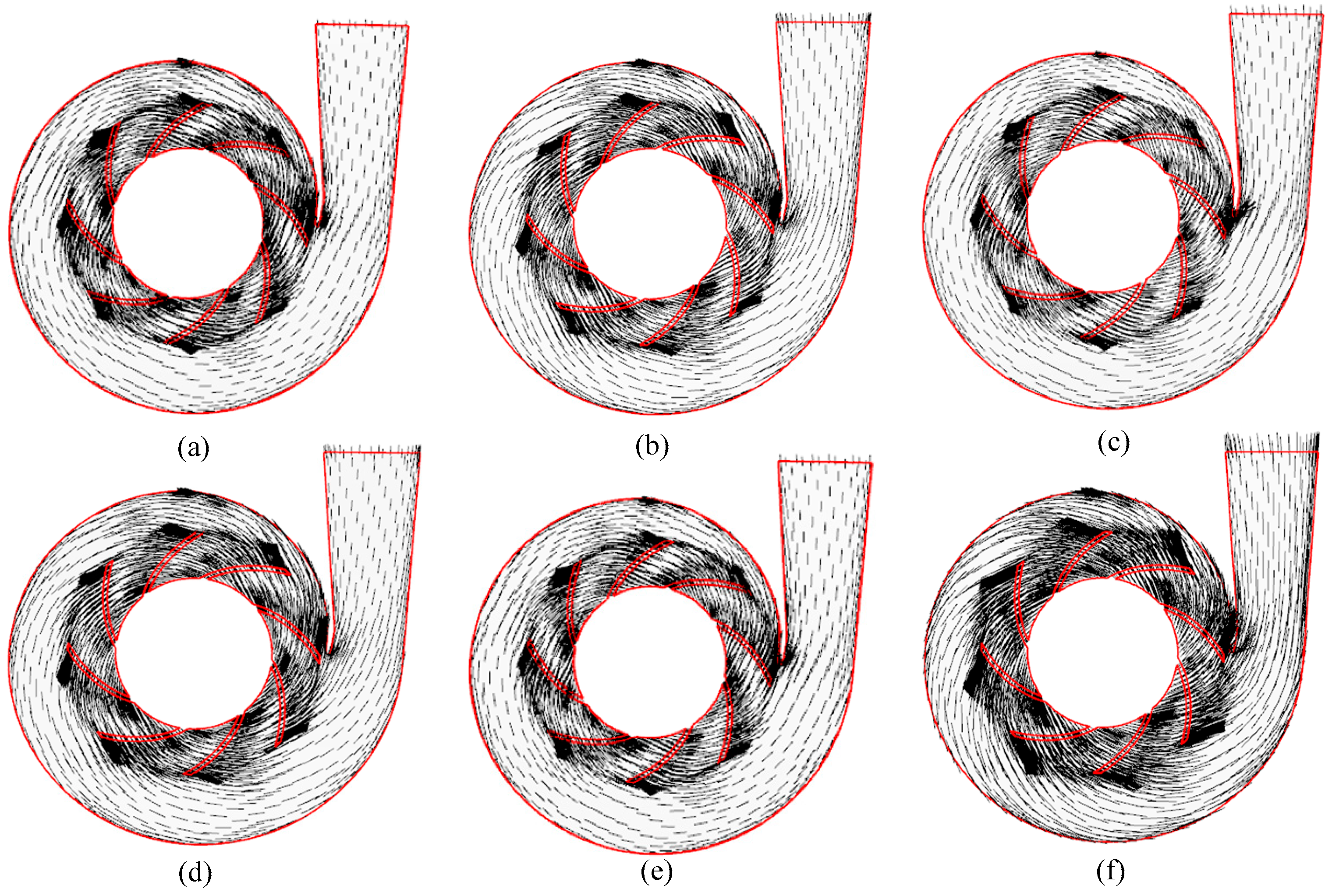
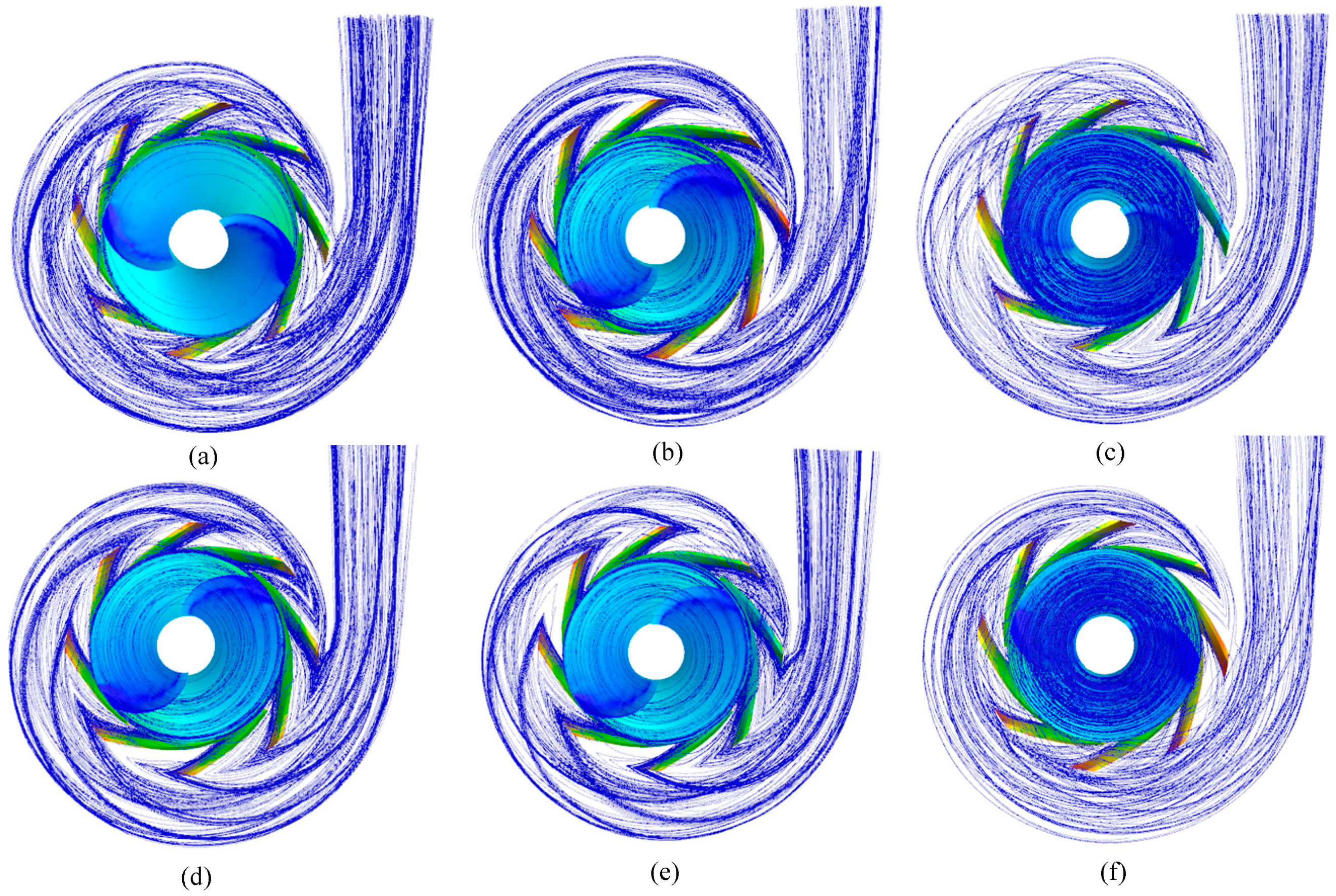
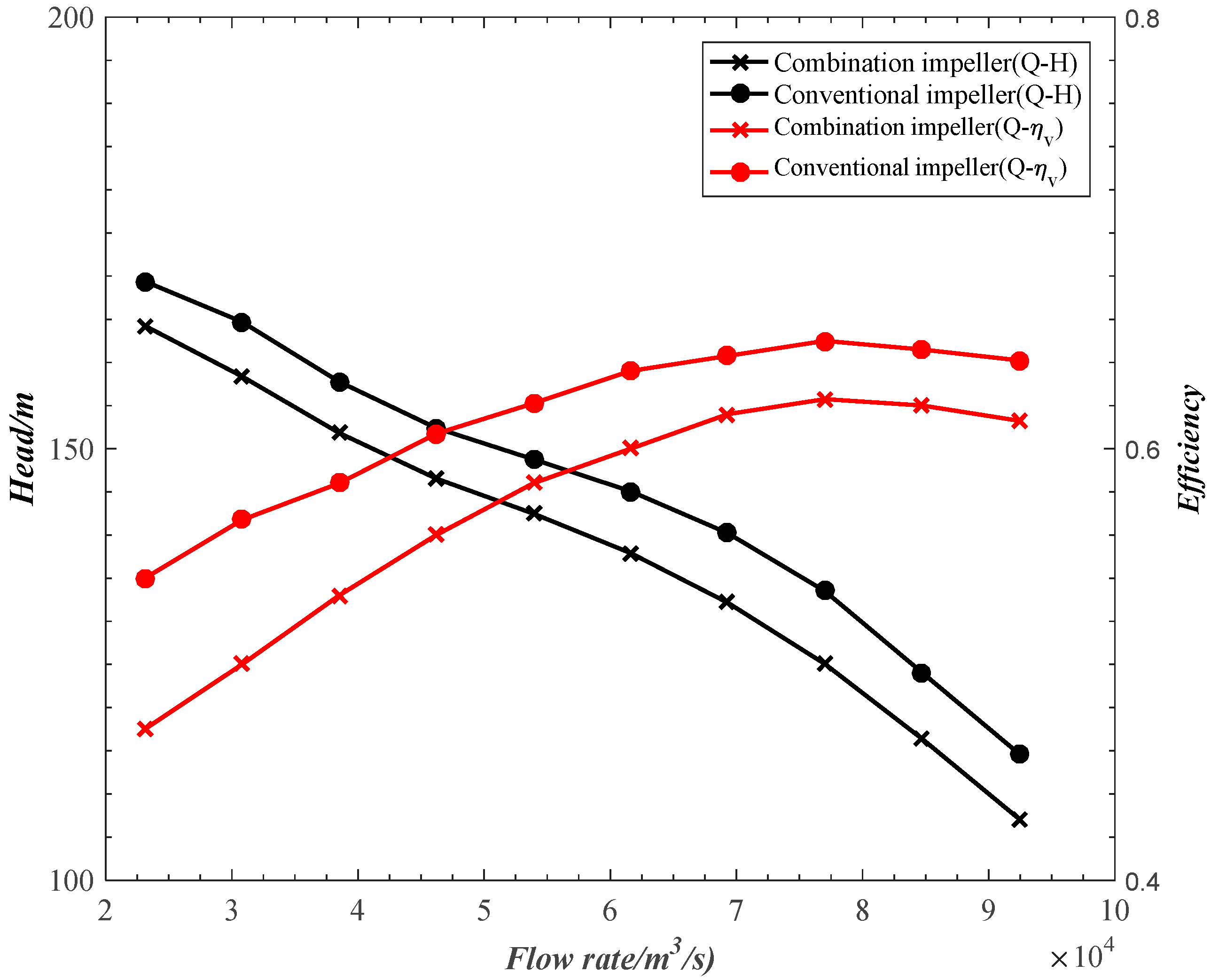
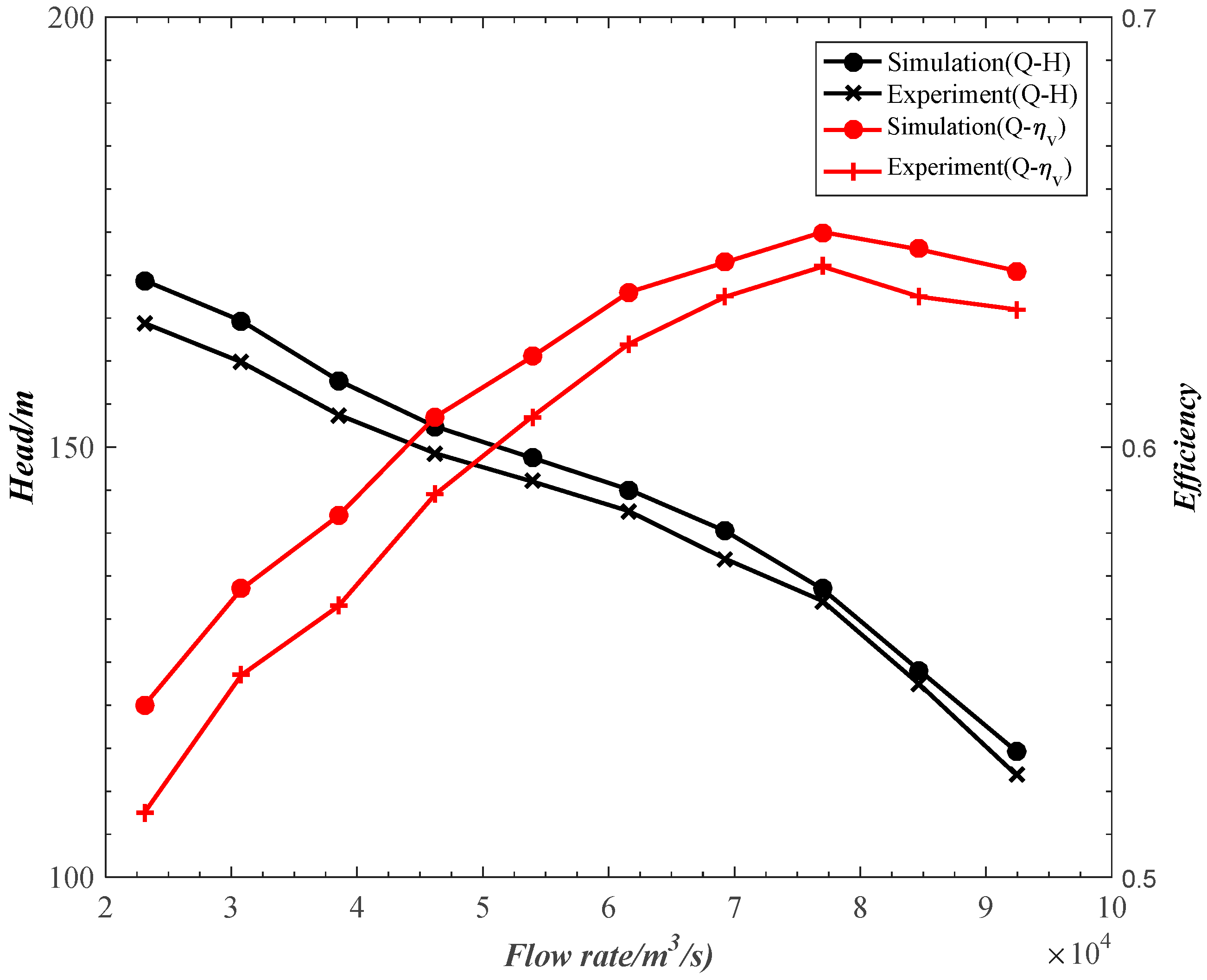
| Performance Parameters | Value |
|---|---|
| Qd (L/h) | 77,000 |
| H (m) | 137 |
| ns | 106.6 |
| ηv | 0.65 |
| Nd (r/min) | 8000 |
| Parameters | Value |
|---|---|
| D1 (mm) | 89 |
| b1 (mm) | 9.8 |
| b2 (mm) | 11 |
| β1 (°) | 22 |
| β2 (°) | 30 |
| D2 (mm) | 117 |
| Db (mm) | 123 |
| b3 (mm) | 15 |
| F8 (m2) | 78 |
| Item | Pump | H | ηv | ||||
|---|---|---|---|---|---|---|---|
| 0.8Qd | 1.0Qd | 1.2Qd | 0.8Qd | 1.0Qd | 1.2Qd | ||
| Grid-1 | 193,268 | 135 | 131 | 121 | 0.598 | 0.611 | 0.622 |
| Grid-2 | 341,456 | 140 | 133 | 124 | 0.643 | 0.65 | 0.646 |
| Grid-3 | 721,138 | 141 | 134 | 123 | 0.644 | 0.651 | 0.645 |
© 2020 by the authors. Licensee MDPI, Basel, Switzerland. This article is an open access article distributed under the terms and conditions of the Creative Commons Attribution (CC BY) license (http://creativecommons.org/licenses/by/4.0/).
Share and Cite
Li, J.; Wang, X.; Wang, Y.; Wang, W.; Chen, B.; Chen, X. Effects of a Combination Impeller on the Flow Field and External Performance of an Aero-Fuel Centrifugal Pump. Energies 2020, 13, 919. https://doi.org/10.3390/en13040919
Li J, Wang X, Wang Y, Wang W, Chen B, Chen X. Effects of a Combination Impeller on the Flow Field and External Performance of an Aero-Fuel Centrifugal Pump. Energies. 2020; 13(4):919. https://doi.org/10.3390/en13040919
Chicago/Turabian StyleLi, Jia, Xin Wang, Yue Wang, Wancheng Wang, Baibing Chen, and Xiaolong Chen. 2020. "Effects of a Combination Impeller on the Flow Field and External Performance of an Aero-Fuel Centrifugal Pump" Energies 13, no. 4: 919. https://doi.org/10.3390/en13040919
APA StyleLi, J., Wang, X., Wang, Y., Wang, W., Chen, B., & Chen, X. (2020). Effects of a Combination Impeller on the Flow Field and External Performance of an Aero-Fuel Centrifugal Pump. Energies, 13(4), 919. https://doi.org/10.3390/en13040919



